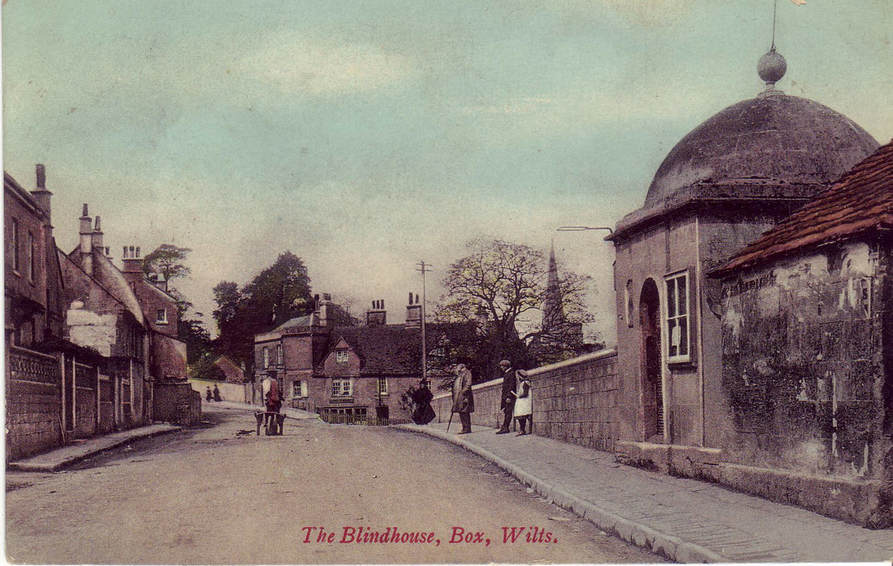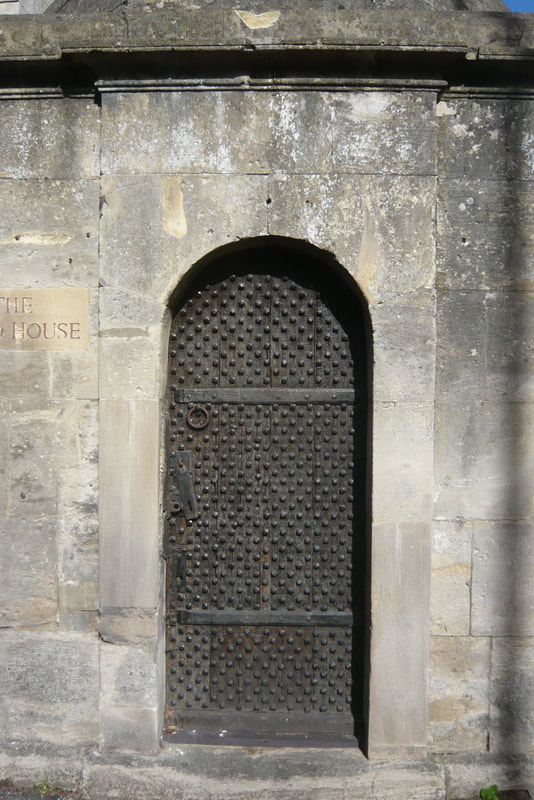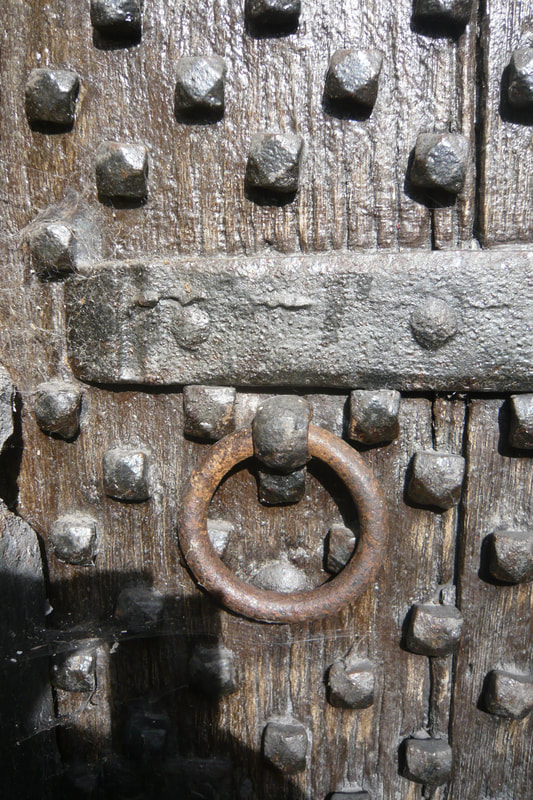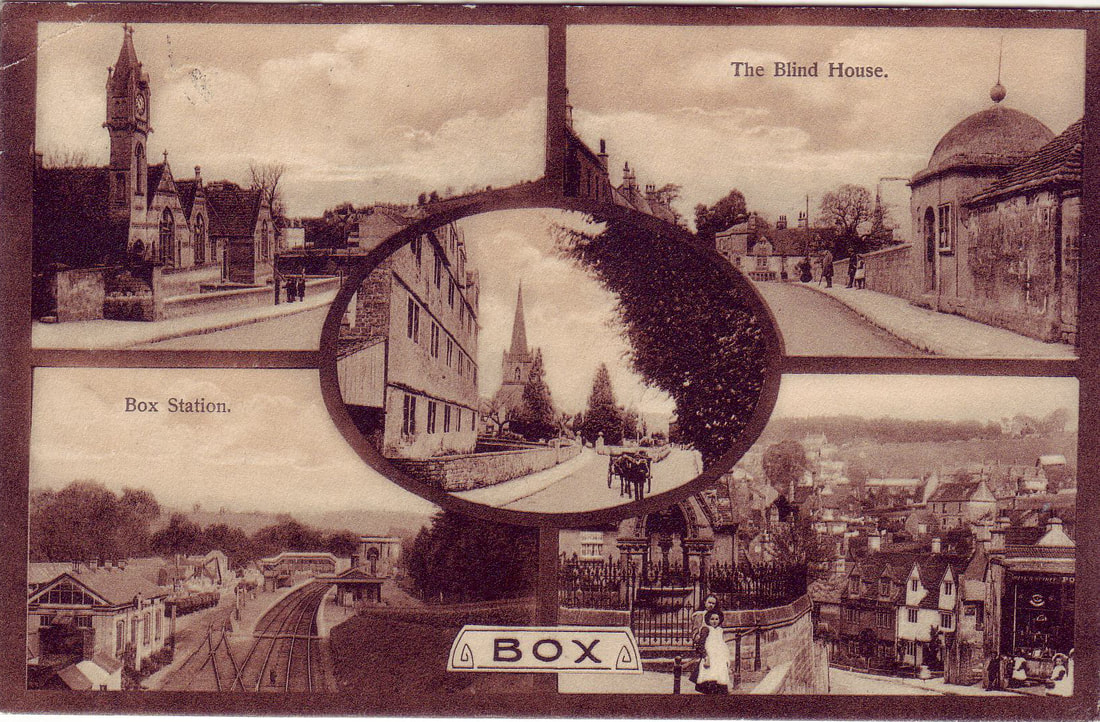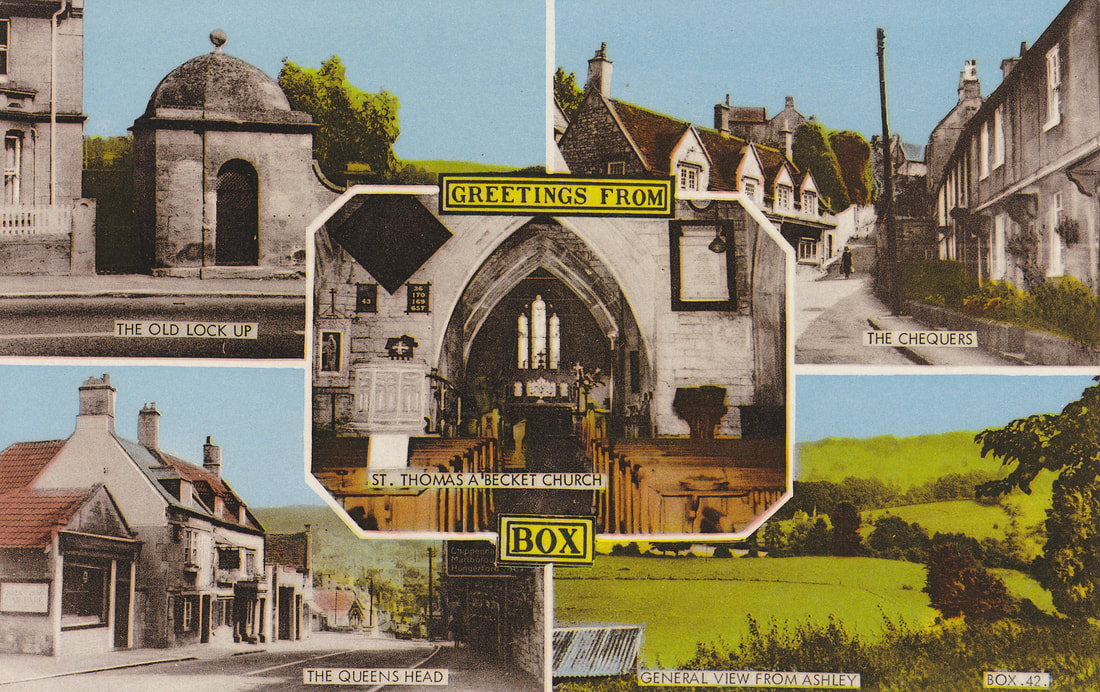Box Blind House Alan Payne January 2022
Research from Box Parish Council archives
Research from Box Parish Council archives
Box Blind House, so called because it has no windows, is one of the many that are found throughout Wiltshire, most built in the 1700s. It was a visible manifestation of civic law and authority, often next door to the stocks which were used for both religious and civic castigation. The public demonstration of authority was important in the years before a police force when the local tythingman (constable) was just an honest and literate local tradesman.
Building the Blind House
We don't have a record of when the Blind House was built but there are two intriguing references in the parish records.[1] There is a long report in 1805 about repairing the building which reads: [2]
Building the Blind House
We don't have a record of when the Blind House was built but there are two intriguing references in the parish records.[1] There is a long report in 1805 about repairing the building which reads: [2]
|
Mason's Work done to the Guard house
Materials & Labour by James Rawlings To Pulling down the Old Wall and digging the foundations &c 11½ Perch Rough Walling to foundations & part in front 403 Feet Freestone Ashler to front and sides 40 ditto Run of Cornice and blocking course 144 ditto Supr Octagon Dome with Cramps let into ditto 7 ditto Run Circular Ramps &c Turn'd Chimney Shaft, and ball on top of dome 76 Feet Paving to Floor and part in front Meas'd 19th March 1805. Thos. Crane Carpenter's Work as by Bill of the same Smith's do. do James Rawlings to make good the broken parts, and the joints in the said work. |
0.6.6 3.9.0 20.3.0 7.0.0 9.12.0 0.14.0 1.0.0 1.18.0 44.2.6 1.6.0 4.10.0 7.1.10½ 57.0.4½ |
The other reference dates the building slightly earlier. The Overseers Accounts in the period from 1767 to 1781 records the payment of a bill for £1-13s-2d from Daniel Arlett for tiles etc on ye Blindhouse.[3] The stone tiles on the domed roof are the most impressive piece of the building, otherwise a rectangular, solid block. The British Listed Buildings Survey gave an estimated date of early 1700s for the original building, now scheduled as a Grade II Listed Building.[4]
Purpose of the Building
The building was constructed specifically as a lock-up to hold petty offenders or trouble-makers for a night or so. Its cramped quarters held minor offenders, drunks, and aliens, strangers from other parishes who looked suspicious who needed to be sent out of the parish. It was controlled by Box's parish authorities, particularly the Overseer of the Poor and the village Tithingman (Parish Constable).
The Box lock-up was built with an elegant exterior design in the middle of Box to reassure villagers that trouble-makers were being dealt with properly. After a night inside, serious cases of misbehaviour were referred to the Justice of the Peace for a pre-trial hearing; minor offences dealt with locally by public denunciation or escort across the boundary into a neighbouring parish.
Purpose of the Building
The building was constructed specifically as a lock-up to hold petty offenders or trouble-makers for a night or so. Its cramped quarters held minor offenders, drunks, and aliens, strangers from other parishes who looked suspicious who needed to be sent out of the parish. It was controlled by Box's parish authorities, particularly the Overseer of the Poor and the village Tithingman (Parish Constable).
The Box lock-up was built with an elegant exterior design in the middle of Box to reassure villagers that trouble-makers were being dealt with properly. After a night inside, serious cases of misbehaviour were referred to the Justice of the Peace for a pre-trial hearing; minor offences dealt with locally by public denunciation or escort across the boundary into a neighbouring parish.
Above: The ancient studded door (photos courtesy Carol Payne)
Inmates
The building has a six-inch grill to allow inspection and the absence of windows which gave it the name Blind House. The domed roof made it difficult for prisoners to escape. Inside it was very basic with a bench to sleep on, fireplace and an earth closet (toilet). When the parish council opened up the fireplace in 1979, it revealed the original bars where we think food was passed in for the inhabitant. There was also a chain in the wall where the victim was restrained by the ankle.[5]
No formal register was ever kept of the people incarcerated in the building but we can suppose that Box's most notorious residents experienced confinement. Perhaps murderers like Craft Ike Smith and Eliza Dorey were kept there awaiting trial. The lock-up had a great deal of use. In 1805 it underwent considerable repair costing the parish £57.0s.4½d (worth today over £5,000).[6] It was the only village law-enforcement building in the years before the formation of Wiltshire Police Force (the first county force established in Britain in 1839).
Other Uses
After a Police House was established in the village at 24 Fairmead View, the building became redundant and fell into disuse.[7]The parish council minutes for November 1906 record a request to the County Council to transfer ownership of the Blind House to the Parish for use as an office for the assistant overseer or as a mortuary ! In 1944 it was reported as being in use within the memory of older Box residents. one anecdote was that it was nearly burnt down when three inmates were held there. They started to smoke and caught fire to the bedding on the bench.[8]
The building later came under the control of the Queen’s Head Pub and was given to the parish council by Courage Brewery in 1978. It is a scheduled ancient monument.
The building has a six-inch grill to allow inspection and the absence of windows which gave it the name Blind House. The domed roof made it difficult for prisoners to escape. Inside it was very basic with a bench to sleep on, fireplace and an earth closet (toilet). When the parish council opened up the fireplace in 1979, it revealed the original bars where we think food was passed in for the inhabitant. There was also a chain in the wall where the victim was restrained by the ankle.[5]
No formal register was ever kept of the people incarcerated in the building but we can suppose that Box's most notorious residents experienced confinement. Perhaps murderers like Craft Ike Smith and Eliza Dorey were kept there awaiting trial. The lock-up had a great deal of use. In 1805 it underwent considerable repair costing the parish £57.0s.4½d (worth today over £5,000).[6] It was the only village law-enforcement building in the years before the formation of Wiltshire Police Force (the first county force established in Britain in 1839).
Other Uses
After a Police House was established in the village at 24 Fairmead View, the building became redundant and fell into disuse.[7]The parish council minutes for November 1906 record a request to the County Council to transfer ownership of the Blind House to the Parish for use as an office for the assistant overseer or as a mortuary ! In 1944 it was reported as being in use within the memory of older Box residents. one anecdote was that it was nearly burnt down when three inmates were held there. They started to smoke and caught fire to the bedding on the bench.[8]
The building later came under the control of the Queen’s Head Pub and was given to the parish council by Courage Brewery in 1978. It is a scheduled ancient monument.
Above Left: In the 1920s (courtesy Box Parish Council) and Right: In the 1970s (courtesy Rose Ledbury)
The Blind House isn't unique; there are eleven similar buildings in existence in Wiltshire at Box, Bradford-on-Avon, Heytesbury, Hilperton, Bromham, Lacock, Luckington, Shrewton, Steeple Ashton, Trowbridge and Warminster. Box is one of the best examples because it has been so little altered inside or outside. Nine others have been lost altogether since they were recorded in 1903, including Amesbury, Chippenham, Colerne, Downton, Maiden Bradley, Malmesbury, Pewsey, Southwick and Sutton Benger.[9] Box Blind House has at times been overlooked, perhaps so obvious that we just walk past it. Not so for those who saw it as a small treasure in the centre of Box and made it the focus of many postcards of the village (above).
References
[1] I am indebted to Jonathan Parkhouse for suggesting these sources
[2] A Shaw Mellor, From Documents Preserved in the Vestry of Box Parish Church, Wiltshire Archaeological and Natural History Society Magazine, 1934, Vol 46, p.107
[3] A. Shaw Mellor, 1935 Box Parish Records - Sidelights on life in a Wiltshire village in the past, 1935, Wiltshire Archaeological and Natural History Society Magazine Vol 47, p.346
[4] See Historic Houses
[5] Details recorded by Mrs Margaret Borthwick for parish council 10 May 1979
[6] Clare Higgens, Box Wiltshire: An Intimate History, 1985, Downland Press, p.91 has some details of this.
[7] Details courtesy Jonathan Parkhouse
[8] The Wiltshire Times and Trowbridge Advertiser, 20 May 1944
[9] DWL Butler, Wiltshire County Solicitor and Clerk, Countryside Sub-Committee, Environment Committee, 14 February 1979
[1] I am indebted to Jonathan Parkhouse for suggesting these sources
[2] A Shaw Mellor, From Documents Preserved in the Vestry of Box Parish Church, Wiltshire Archaeological and Natural History Society Magazine, 1934, Vol 46, p.107
[3] A. Shaw Mellor, 1935 Box Parish Records - Sidelights on life in a Wiltshire village in the past, 1935, Wiltshire Archaeological and Natural History Society Magazine Vol 47, p.346
[4] See Historic Houses
[5] Details recorded by Mrs Margaret Borthwick for parish council 10 May 1979
[6] Clare Higgens, Box Wiltshire: An Intimate History, 1985, Downland Press, p.91 has some details of this.
[7] Details courtesy Jonathan Parkhouse
[8] The Wiltshire Times and Trowbridge Advertiser, 20 May 1944
[9] DWL Butler, Wiltshire County Solicitor and Clerk, Countryside Sub-Committee, Environment Committee, 14 February 1979
